#gaki jigoku
Explore tagged Tumblr posts
Text







More color scheme art
Please also look here:
This campaign is vetted here. Low on funds, €3,413 / 50k ≈ 7%
#artists on tumblr#boost post#vetted#low on funds#huevember#15th doctor#doctor who#ncuti gatwa#disco#70s aesthetic#hell baby#horror manga#hideshi hino#gaki jigoku#dr robotnik#robotnik junior#sonic fanart#sonic underground#sonic au#nevenfam
24 notes
·
View notes
Text
basic information : yuyu yayahara
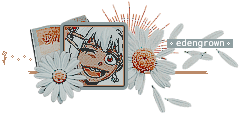
info under cut

NAME. yuyu yayahara AGE. around 170 GENDER. female ALIASES. gao-gao ( literal growling ) AFFILIATIONS. gotei 13 ( division 8 ; lieutenant ) ZANPAKUTO. kuma no tsume ( bear claws ) SHIKAI. acrylic nails ➢ release command : literal bear growling / roars ➢ after using her release command, yuyu's zanpakuto turns into acrylic nails, xxl length and designed after whichever nail trends she's into at the time ➢ with her shikai released, yuyu can use her hands to either mimic bear teeth or claws, allowing her to summon an apparition of a giant bear head behind her ( said bear head is strong enough to decapitate a jigoku no gaki in a single bite ) BANKAI. kuma no tsume : ōguma-za ( bear claws : ursa major ) ➢ similar to komamura, yuyu's bankai allows her to fully manifest her bear apparition as a fully solid giant bear ➢ unlike komamura, however, yuyu's bear is an actual living entity that can act on it's own and must usually be bribed to follow yuyu's orders ( yuyu typically bribes her bear with either hollows or her own reiatsu ) ➢ the bear's strength is relative to yuyu's reiatsu ( the more energy she has, the stronger her bear ) and if it gets damaged, the only way to heal it is to feed it hollows or use yuyu's own reiatsu ➢ while her bear's strength is based on her reiatsu, yuyu does not share damage with her bear OTHER INFO. ➢ while being a capable lieutenant, yuyu is often looked down upon by others at her rank or higher due to her style choices and the fact that her zanpakuto is always released ( she says it's because she likes having acrylic nails, but the truth is that her zanpakuto's sealed form is so embarrassingly large compared to her that she'd rather have the nails ) ➢ yuyu has an absurd amount of strength, allowing her lift at least 500lb objects with ease and shatter a jigoku no gaki's sternum with her footfalls while running on it's spine ➢ yuyu yayahara isn't her real name ( she chose yuyu yayahara because she wanted a cuter name to match her gyaru aesthetic ) ; her real name is secret only those close to her or those above her in rank know ➢ yuyu is a kogal gyaru and spends a lot of time and money to keep up appearances ; her morning routine is at least 2 hours long and she has to spend a decent chunk of her paycheck to keep up her hair, nails, make-up, and clothing purchases
#headcanons. yuyu.#sHES FINALLY HERE#FOR LITERALLY 2 OF MY MUTUALS#also im still catching up on bleach so please be patient with me if i get info mixed up or yuyu is a bit ooc#altho her being ooc isnt a big deal to me bc theres such little info about her and shes p much gonna be an oc for me bUT WHATEVER-
2 notes
·
View notes
Text



i brought it up in the tags of a random reblog but I can't believe the digital colorist for the Hell Arc oneshot went with a weird purple color for Szayel's hellbound robes? (and in general the color choices on the gaki were ugly as sin) the obvious choice to me seemed to be orange, because it's both a common and iconic color for that kind of over the shoulder buddhist robe that would tie into Bleach's cosmology, but also the iconic orange robes of the Abashiri prison, something Yamamoto's bankai also seemed to have referenced.
They're prisoners not just of "hell" in the sense that jigoku etymologically is a literal "prison", but prisoners of the wheel of reincarnation, which is the basis of what buddhism and the search enlightenment and nirvana is, an escape from the cycle of suffering that is life the death.
17 notes
·
View notes
Text

Hell Baby (餓鬼地獄)
By Hideshi Hino
72 notes
·
View notes
Text

0 notes
Text
bleach spoilers but oh my god?????????????? from the wiki
“Konsō Reisai (魂葬礼祭, Soul Burial Ceremony Ritual) is a unique, ceremonial version of Konsō performed twelve years after the funeral rites of Gotei 13 captains who perished in battle, where the current captains and lieutenants capture a Hollow and purify it in front of the grave of the deceased captain.[4] Due to the Reishi comprising captains' bodies being too dense with Reiatsu, placing them in the upper three tiers of Spirit Class (霊威, Reii), it cannot naturally break down and be reabsorbed by the soil of Soul Society without intervention, with the ceremony supposedly being used to manually enact this phenomenon. However, the truth is that such potent Reishi can never be reabsorbed by Soul Society, and since allowing overly powerful Reishi to linger in Soul Society indefinitely poses a great risk, the true purpose of the ceremony is to cast deceased captains into Hell.[5] Moreover, the format of the ceremony is notably flexible; though the standard practice consists of purifying a normal Hollow in front of a captain's grave in Soul Society, Jūshirō Ukitake was successfully cast into Hell after his death when Ichigo Kurosaki and the lieutenants slaughtered several Jigoku no Gaki in the Human World while Ichigo was carrying his Substitute Shinigami Badge, therefore allowing Ukitake to witness it.[6]“
i’m hysterical.... soul society is full of so many fucked up secrets like thanks for all your hard work. but if you rule too fucking hard at your job we have to send your soul to HELL
3 notes
·
View notes
Text
kaidos inspiration is the shuten doji and his crew shares his oni theme
kaido resembles the modern day oni) (the horns, and the thing that kaido wears resembles what onis wear, the loincloth and the bracelets onis are depicted with kaidos spiked bracelets
en . wikipedia . org/wiki/Oni there is the expression “oni with an iron club” (鬼に金棒 oni-ni-kanabō?), that is, to be invincible or undefeatable. It can also be used in the sense of “strong beyond strong”, (matches kaidos description and equivalent to kaidos strongest creature title) or having one’s natural quality enhanced or supplemented by the use of some tool. ) for it was said no one could kill him and that he is the strongest creature on land , sea and air
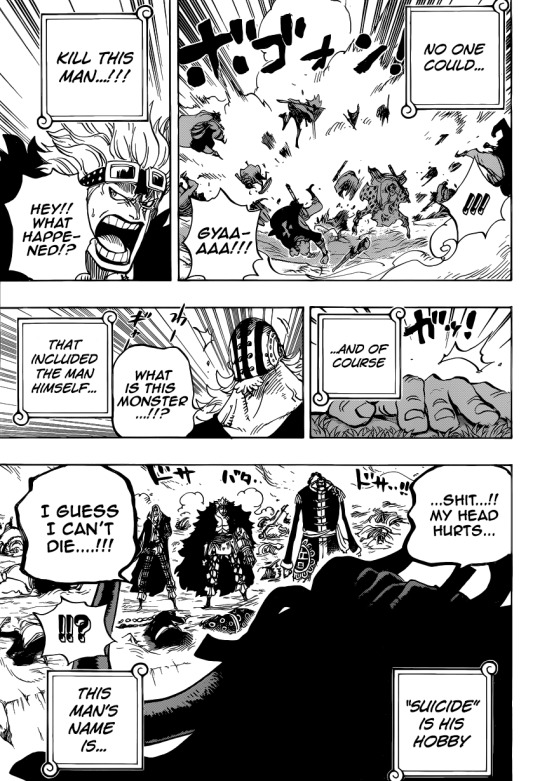

and the fortress of the oni in the momonosuke story resembles the place we saw where the guy called for kaido.

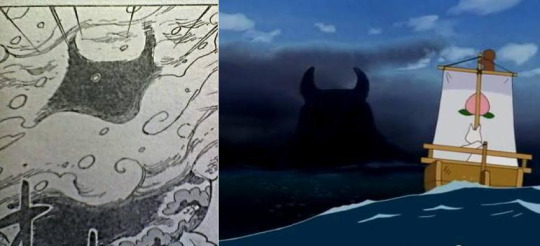
in its shape they are the same
kaidos island and the demon island that momotaro went to in the story have the same name Onigashima.
Kaido’s characteristics such as his weapon, appearance, position as King of Onigashima (for being “king of ogres/demons”), also corresponds to the character of Shuten-Dōji and Momotarō legend in which orges of Onigashima were defeated by Momotarō and three animals, a possible inspiration source of Momonosuke ( who gotten the help of luffy (monkey) and inuarashi the dog only the pheasant is missing but japanese phoenixes have the head of pheasants so marco could represent the pheasant) ,
or the monkey, dog, and pheasant could be luffy, garp ( who wore a dog mask) and his ship had a dog on the helm and was one of the people who took down the original rocks pirates ) and dragon opforum . net/threads/wanos-new-monster-trio . 96982/
Tama (Her unnamed Devil Fruit power seems to be based on Momotarō of Japanese folklore, who also used kibi dango to recruit his three beastly retainers: a dog, a monkey, and a pheasant. So far, Tama is known to have befriended two of the same three types of animals that Momotarō has; only the pheasant is missing) , and her befriended animals.
The word “oni” is sometimes speculated to be derived from on, the on'yomi reading of a character (隠) meaning to hide or conceal, as oni were originally invisible spirits or gods which caused disasters, disease, and other unpleasant things. These nebulous beings could also take on a variety of forms to deceive (and often devour) humans. Thus the Chinese character 鬼 (pinyin: guǐ; Jyutping: gwai2) meaning “ghost” came to be used for these formless creatures.
and kaido representing an oni since moriah coveted the corpse of oars and oars jr who resembled an oni (onis skin may be any number of colors, but red and blue are particularly common.)
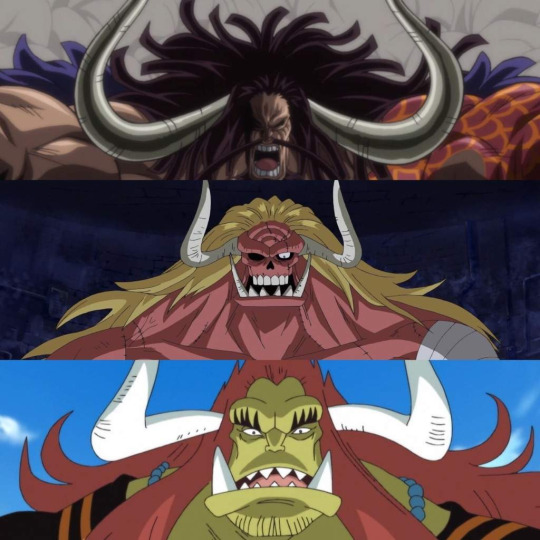
and kaidos top 3 guys are called the calamities/disasters ( which basically mean the same thing)

the more accurate translation
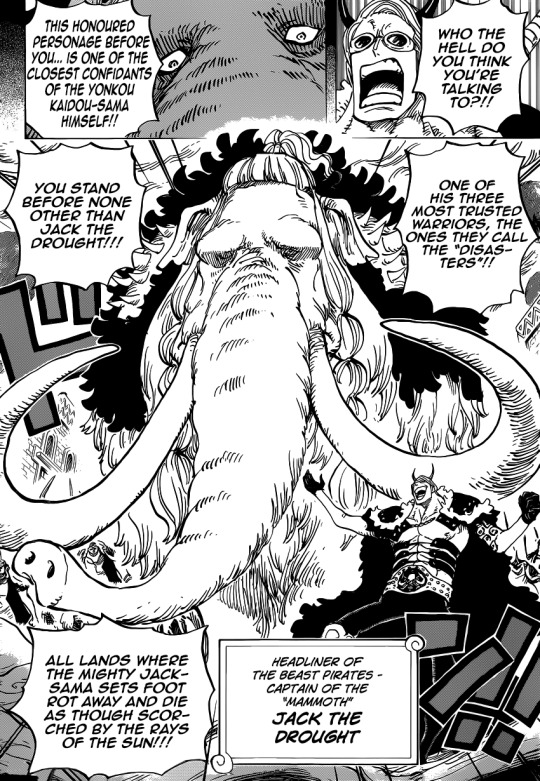
jack the drought (unpleasant things , queen the plague (diseases) , king the wildfire ( disaster) all three of their epitaphs reference something onis bring
oni are said to crush and destroy humans solely for enjoyment carry out horrible punishments (kaido boiled oden) and make up armies of the great generals of the underworld(the zoan army)
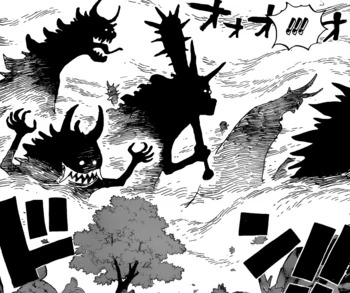
They all possess two horns on their head, much like Kaido, and two of them carry a spiked club similar to Kaido’s kanabō, thus giving them traits similar to those of the legendary oni
The invisible oni eventually became anthropomorphized and took on its modern, ogre-like form, partly via syncretism with creatures imported by Buddhism, such as the Indian rakshasa and yaksha, the hungry ghosts called gaki, and the devilish underlings of Enma-Ōwho punish sinners in Jigoku (Hell).They share many similarities with the Arabian Jinn.
Doflamingo’s title was “Heavenly Yaksha” and it would fit for him to work for a guy who represents an oni like how he represents a yaksha and oniare portrayed as having massive size
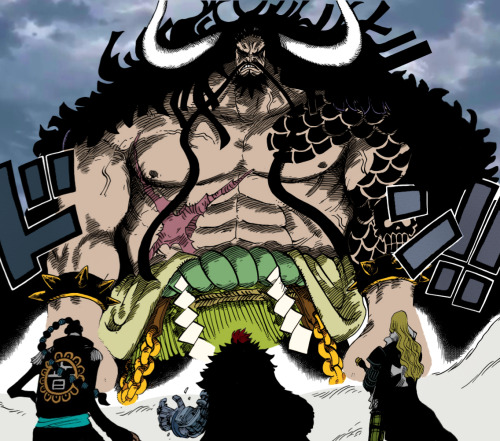

and kaido was shown with an iron club

kaido doesnt just allude to oni in general but specifically to the shuten doji the king of the oni who had a fondness for alcohol and went on drunken rages
en . wikipedia . org /wiki/Shuten-d%C5%8Dji
There is a proverb in Japan Oni no Me nimo Namida (鬼の目にも涙 Even ogres/demons shed tears.?), meaning “even the hardest of hearts can be moved to tears”. This also fits to Kaido’s side to be a maudlin drinker and pitied for Doflamingo.
Kaido (怪童 “Mysterious Kid?) or Kaidomaru (怪童丸?) are also old names for both Shuten-Dōji and Sakata no Kintoki in their youths
about shuten doji( 酒呑童子 or 朱点童子 )
en . wiktionary . org/wiki/%E6%9C%B1#Kanji
Shutendoji is made with the character ‘sake’ … (酒呑童子) the word "sake” (酒, “liquor”, also pronounced shu)
nihongoichiban . com/2011/07/02/%E9%85%92/
and kaido was drinking from a sake gourd
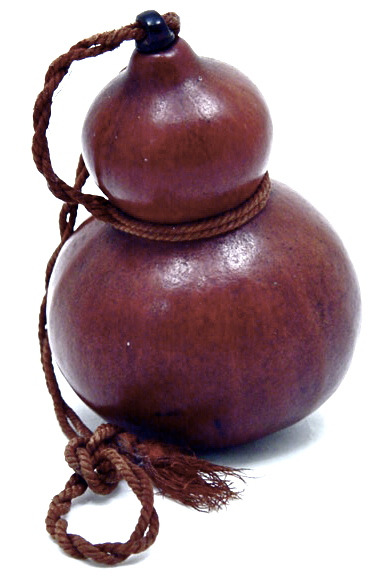
and the kanji for “Ten” was written on the bottle which kaido was drinking
天
en . wiktionary . org/wiki/%E5%A4%A9
the word “sake” (酒, “liquor”, also pronounced shu)
There are three monsters who are considered the greatest and most evil yokai in all of Japanese folklore: the ghost of Emperor Sutoku, the nine-tailed kitsune Tamamo no Mae, andthe dreaded king of the oni, Shuten dōji. He met another demon child like him, named Ibaraki dōji (most likely inspiration for 1st mate of kaido), who became his chief servant. Over time, the young man and his gang gradually transformed into oni, and eventually he had a whole clan of oni (beast pirates ) and yokai thugs who prowled the highways, terrorizing the people of Kyoto in a drunken rage. He and his gang eventually settled on Mount Ōe, where, in a dark castle, he plotted to conquer the capital and rule as emperor. Finally, a band of heroes led by the legendary warrior Minamoto no Yorimitsu managed to defeat
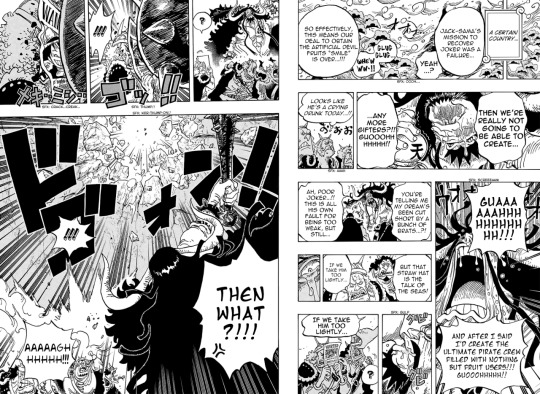

the kanji for “Ten” was written on the bottle which kaido was drinking which combined with shu gets shuten
en . wiktionary . org/wiki/%E5%A4%A9
so
It has been said that Shuten-dōji was the strongest oni of Japan. Academic folklorist Kazuhiko Komatsu (ja) has counted Shuten-dōji among the three most feared yōkai in medieval Kyoto, alongside the vixen Tamamo-no-Mae and the demon Ōtakemaru (ja).
shuten doji wasnt born an oni
Shuten dōji was a troublesome orphan child. He was very strong and very smart; so much so that people believed his father must have been a demon or a dragon (some stories has shuten dojis father be the 8 headed dragon yamato no orochi ( sometimes its depicted as a dragon in others its depicted as a snake. and he later became an oni
folklorethursday . com/legends/three-evil-yokai-japan/#sthash.EtH9NC71.dpbs

kaido as a drunk dragon going on a revelation
and kinemon has a hatred for dragons plus this supports so it fits that kaido ate the dragon df it reflect the parts in shuten dojis story where they were connecting shuten doji to dragons.
Kaido’s habits to favor alcohol and to lose self controls are similar to the legend of Yamata no Orochi, a famous hydra like dragon and incarnation of floods, or a god of mountains and rivers in Japanese mythology (Yamata no Orochi (八岐大蛇 (ヤマタノオロ��), “8-branched giant snake”) or Orochi (大蛇), is a legendary 8-headed and 8-tailed Japanese dragon so in depictions the yamata no orochi is sometimes portrayed as a snake and sometimes its depicted as a dragon where a character who is supposed to allude to the orochi can have a snake theme )i, and Shuten-Dōji, lord of demons and bandits who was slain by famous Shitennō
and some storys connect shuten doji to the yamata no orochi and orochi from one piece works for kaido (both the shuten doji and yamata no orochi possessed a matchless thirst for sake (some say orochi fathered shuten doji
and Both Yamata no Orochi and Shuten-Dōji were slain by being incapacitated with alcohol. and their heads being cut off
the yamata no orochi was killed by susanoo the storm god ( and roronoa zoro has multiple storm based attacks) by susanoo getting all of yamata no orochis heads intoxicated to the point it fell asleep and while it was asleep susanoo killed it so sake played a part in its demise
en . wikipedia . org/wiki/Yamata_no_Orochi
So His-Swift-Impetuous-Male-Augustness, at once taking and changing the young girl into a multitudinous and close-toothed comb which he stuck into his august hair-bunch, said to the Deities Foot-Stroking-Elder and Hand-Stroking-Elder: “Do you distill some eight-fold refined liquor. Also make a fence round about, in that fence make eight gates, at each gate tie [together] eight platforms, on each platform put a liquor-vat, and into each vat pour the eight-fold refined liquor, and wait.” So as they waited after having thus prepared everything in accordance with his bidding, the eight-forked serpent came truly as [the old man] had said, and immediately dipped a head into each vat, and drank the liquor. Thereupon it was intoxicated with drinking, and all [the heads] lay down and slept. Then His-Swift-Impetuous-Male-Augustness drew the ten-grasp sabre, that was augustly girded on him, and cut the serpent in pieces, so that the River Hi flowed on changed into a river of blood. So when he cut the middle tail, the edge of his august sword broke
maybe odens sword ame-no habakiri will end up breaking
The Ame no Habakiri (天羽々斬あめのはばきり Ame no Habakiri?, literally meaning “Snake-Slayer of Heaven”) is one of the most famous Totsuka no Tsurugi, appearing in Japanese mythology as a blade used by the Shinto god Susanoo to slay the legendary monster serpent Yamata no Orochi. “Haba” (羽々?) is an archaic term for “big snake” (orochi).
maybe zoro will end up being given the ame no habakiri after he kills orochi and the sandai kitetsu breaks to signify his status as the person who killed orochi
and for shuten doji
The gods give Raikō the “sake [which is] divine elixir, poisonous to demons” (神便鬼毒酒, jinben kidoku shu)[l] which will rob the ogres of their ability to fly and stupefy them
As in the oldest text, Raikō’s party pretending to be yamabushiascetics gains entry at Shuten-dōji’s dwelling-place. Raikō disarms the ogre’s suspicion by explaining that they as yamabushi follow the ways of En no Gyōja who he says was compassionate and hospital towards demons.[35] The warriors drink up the blood sake and heartily eat the human flesh in order to gain furthter confidence.[36] At the height of the drunken revelry, Raikō offers Shuten-dōji the divine sake poisonous to demons.[37] Shuten-dōji begins to tell his life story (he is originally from Echigo Province according to this text), and also recounts how his henchman Ibaraki-dōji lost an arm in an encounter with Tsuna, one of Raikō’s men.[n][38]
As in the older text, the warriors equip their hidden armor and swords and raid Shuten-dōji in his sleeping chamber. The three gods have arrived to help and chain the ogre’s limbs to the pillars. As Raikō positions himself with his sword Chisui in hand, the ogre faults the warrior for his sneaky underhanded tactics, exclaiming: “How sad, you-priests! You said you do not lie. There is nothing false in the words of demons”. The warriors attack with their swords and sever Shuten-dōji’s head, but as in the older text, the detached head attempts to get a bite at Raikō, and the hero is protected by two helmets stacked on his head: his Lion King helmet on top the hobnailed helmet (hoshi kabuto (ja)) given him by the gods. Subsequently, Ibaraki-dōji and Watanabe no Tsunaengage in a prolonged fight and while they grappled, Raikō decapitated Ibaraki-dōji. The female prisoners are liberated and the warriors return triumphant.
so alcohol played a part in both orochi and shuten dojis death and the original plan was to kill orochi and kaido while they were drunk partying
and one of the methods of ancient japan to ward off onis were to erect monkey statues and sun wukong who luffys based off was a stone monkey a monkey born from the stone and given moriahs connection to luffy moria may be involved in wano and nightmare luffy will return
3 notes
·
View notes
Note
Bad Ass Temple Bad Ass Temple Bad Ass Temple Bad Ass Temple Bad Ass Temple
East Side (C’mon) West Side (C’mon) North Side (C’mon) South Side (C’mon) East Side (C’mon) West Side (C’mon) North Side (C’mon) South Side (C’mon)
reprezen nagoya maiku ubaou ka uragiri wa hou ni nottori sabakou ka I’m a amaguni hitoya Hitoban de hittoraeru tengoku to jigoku no hito da nougaki naraba ronpa suru zo gaki roppou zensho wa subete anki keihoudai nihen sanjuugoshou shinyou oyobi gyoumu ni taisuru tsumi de omae wo soshou yoshi, sou shiyou ore ga kou shiyou to omoeba sono shirokuro sae mo jitsuryoku koushi yo pen to ken futatsu motsu bengoshi anken wa kane de mendou miru
Heaven & Hell…
I Got One For The Money I Got Two For The Show gaman naran mon ga anze hanashi wo kika nakan te I Got One For The Money I Got Two For The Show… For Sure!
tabako fukasu suki na mon futatsu ai ra UISUKII to okane ijime wa kasu kotogotoku batsu tatoe RISUKII demo tada ja okanee subuta no PAINAPOO wa ikan ga sugu mushi wa nai daro shuushi nakimushi de owari na no? misero nagoya dibijon orera “owari” daro Hey Yo! temee no jinsei kirihirake He Say, She Say, dou demo ii ze tebasaki katate ni riizento kimete itsudatte rinsen taisei
Heaven & Hell…
I Got One For The Money I Got Two For The Whiskey gaman naran mon ga anze maketara maa kan te I Got One For The Money I Got Two For The Show… For Sure!
nakanu nara naku made matou nakanu nara nakasete miseyou iya, namanurii ze nakanu nara koroshite shimae! C’mon When I Say Bad Ass You Say Temple Bad Ass! (Temple!) Bad Ass! (Temple!) When I Say Bad Ass You Say Temple Bad Ass! (Temple!) Bad Ass! (Temple!)
Heaven & Hell…
I Got One For The Money I Got Two For The Show gaman naran mon ga anze hanashi wo kika nakan te I Got One For The Money I Got Two For The Whiskey gaman naran mon ga anze maketara maa kan te I Got One For The Money I Got Two For The Show… For Sure!
Hey! Hey! Nagoya Division MC Heaven & Hell I'm a Amaguni Hitoya
No. 🖊
1 note
·
View note
Photo

“An old etymology for "oni" is that the word derives from on, the on'yomi reading of a character (隠) meaning "to hide or conceal", due to oni having the tendency of "hiding behind things, not wishing to appear". This explanation is found in the 10th century dictionary Wamyōshō, which reveals that the oni at the time had a different meaning, defined as "a soul/spirit of the dead".[9][10]
The character for oni, 鬼 (pinyin: guǐ; Jyutping: gwai2) in Chinese also means a dead or ancestral spirit, and not necessarily an evil specter.[9] Accordingly, Chinese (Taoist) origins for the concept of oni has been proposed by Takahashi Masaaki (ja).[11]
But the oni was syncretized with Hindu-Buddhist creatures such as the man-devouring yaksha and the rakshasa, and became the oni who tormented sinners as wardens of Jigoku (Hell),[12] administering sentences passed down by Hell's magistrate, King Yama (Enma Daiō).[6] The hungry ghosts called gaki (餓鬼) has also been sometimes considered a type of oni (the letter "ki" 鬼 is also read "oni").”
Source: https://en.wikipedia.org/wiki/Oni
“Hungry ghost is a concept in Chinese Buddhism and Chinese traditional religion representing beings who are driven by intense emotional needs in an animalistic way. The term 餓鬼 èguǐ, literally "hungry ghost", is the Chinese translation of the term preta in Buddhism. (...) Hungry ghosts, by contrast, are a much more exceptional case, and would only occur in very unfortunate circumstances, such as if a whole family were killed or when a family no longer venerated their ancestors.[3]”
Source: https://en.wikipedia.org/wiki/Hungry_ghost

#the crimes of grindelwald#fantastic beasts#circus arcanus#fbtcog#fantastic beasts oni#fantastic beasts sequel
7 notes
·
View notes
Note
Do you like any of Hideshi Hino's work? I read his Gaki Jigoku, Panorama of Hell, and Lullabies from Hell. I also saw a couple of his guinea pig movies. And all I can say is 'whoa'.
Yeah, I like him a lot! Probably in my top 5 as far as horror mangaka are concerned. The Bug Boy was the first I ever read and it was so disgustingly funny that I binged on everything else I could find. His manga has the blunt, gory comedy of The Evil Dead movies, Peter Jackson’s Braindead, etc.
I don’t really like Guinea Pig though. I’d seen those movies long before I even knew who Hino was, so when I discovered his manga I checked it out again and actually thought less of it than I did first time. It has none of the Hino playfulness that I enjoy him for. I hear Mermaid in a Manhole is closer to his manga style, but I still haven’t seen it yet.
16 notes
·
View notes
Photo
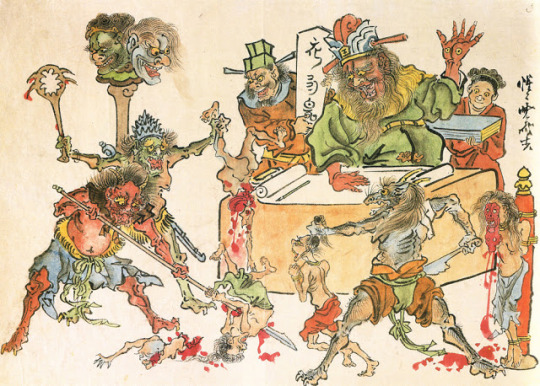
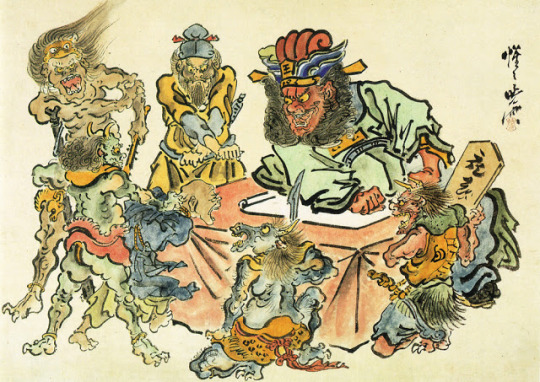
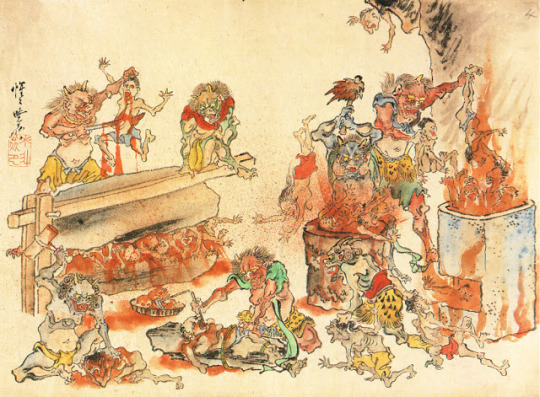
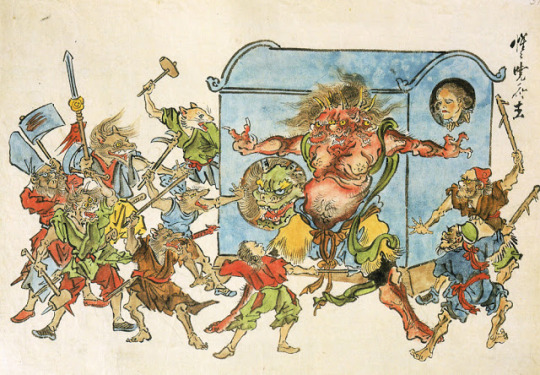
THE JAPANESE UNDERWORLD: YOMI, JIKOKU AND MEIDO
Yomi no kuni is the Japanese word referring to the land of the dead or the world of darkness. It’s where the dead go in the afterlife. Once a soul go there it’s impossible for it to return in the realm of the living. This realm of darkness is geographically linked with this world. Like hell in other culture, this realm is beneath the earth.
Yomi is ruled by Inazami no Mikoto, the Grand Deity of Yomi. According to the book Kojiki, the entrance to this realm lies in Izumo province.
Jikoku is the Buddhist hell. Buddhist hell are depicted in hell scrolls ( Jikoku – zoshi). These scrolls were made towards the end of the Heian period. They show through pictures what it’s awaiting people that behave bad in life. Apart from the main eight hells, there are also 16 lesser hells. Different hells correspond to different crimes. The king who rules over these hells is King Enma.
Meido is a place where souls go before they go to Heaven or get reborn or get cast to Hell. It’s the first step for souls on their way to the next life. When a person dies, she/he can go to Heaven ( Tengoku) or Hell ( Jigoku). Meido is a sort of Purgatory, when people go in they did both good and evil in their life. To enter this realm, the soul must find and cross the Sanzu River that is a boundary between our world and the world of the dead.
The Sanzu River is said to be located on Mount Osore ( Osore in Japanese means “fear”) in northern part of the isle. This mount is one of the holiest and mysterious places in Japan. On his rocks there are hallucinogenic mushrooms known as skull mushrooms, used by blind shamanesses ( itako) to communicate with the dead.
Upon dying a soul is visited by three oni who escort the soul on a 7 days journey to Meido. This journey is terrible, painful and difficult. After 7 days, the soul arrives at the Sanzu River and faces the first trial, judged byt King Shinkou. To cross this river a toll of 6 mon ( old form of currency) is required. This toll is buried with the deceased and those souls who don’t have it, they can’t cross the river. The seventh day after death is an important day, prayers are told to help a soul during this trial and the following river crossing.
One part of this river is crossed by a bridge while another part of the river is shallow. The rest of it it’s full of snakes. The soul with the most good deeds cross the bridge, other with both good and evil deeds cross the river in the shallow part and the others have to swim in the water with snakes. It takes 7 days to cross this river.
After this long step, the soul meets two oni: Daetsuba and Ken – e – ou. They take the clothes from each soul and hang them on the trees. The amount of branch bend under the weight of the clothes serves as a measure of the weight of the sin of each soul.
The second trial takes place 14 days after death and it’s held by king Shokou. He sends the bad souls straight to hell, while the good ones can pass on the next trial. Before the third trial, which is held 21 days later after death, the soul must pass through a gate guarded by oni. The third trial is held by king Soutei, here too, evil souls go straight to Hell, the good ones pass on the next trial.
The fourth trial, which occurs 28 days later after death is held by king Gokan. He judges the dead on the number of lies they told in life using a stone. He weighs each soul against a large stone, the number of stones it takes to takes the balance determines how much this soul has sinned. If a soul passes this trial, he must cross a desolate land under a rain of red hot balls of iron.
The fifth trial, 35 days after dead is held by king Enma, ruler of the underworld. He shows each soul a large mirror. The king decides, based on the previous trial which one of the 6 realms the soul will be reborn into: the realm of Heaven, Humans, Asuras, Beasts, Gaki or Hell.
After 42 days, the souls are judged again by king Henjou, he decides the location of each soul’s rebirth. The souls after travelling across a dark land, after 49 days from death the souls arrive in front of King Taizan. This day is really important because it is the final chance to avoid Hell. After this, each soul moves on a road with 6 unmarked torii gates, each representing one of the Buddhist realms: each soul must decide which one to choose. The souls, after the choice, travels along a frozen river and leave Meido.
Source: Matthew Meyer - The Night Parade of One Hundred Demons: A Field Guide to Japanese Yokai
Images: Kawanabe Kyōsai - Depictions of the Japanese hell
182 notes
·
View notes
Photo
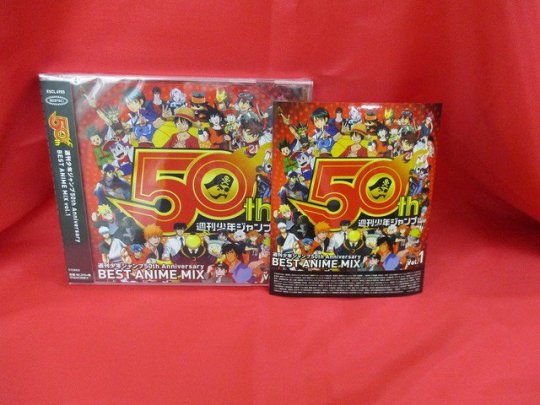
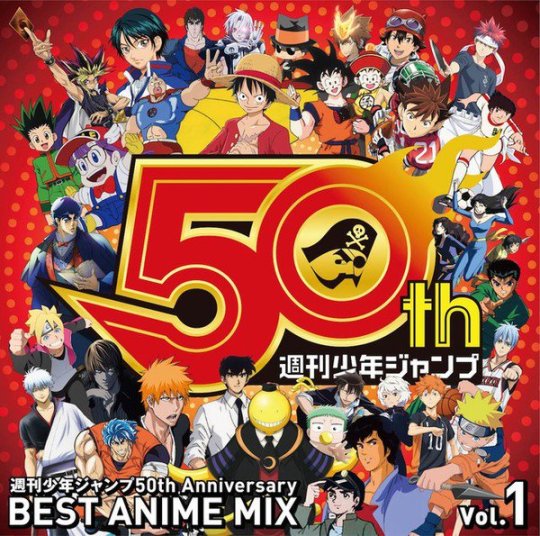
From Anime News Network
Celebrate 50 Years of Shonen Jump's Best Theme Songs
posted on 2017-12-20 03:45 UTC-8
by Jennifer Sherman
Shueisha's Weekly Shonen Jump magazine is celebrating its 50th anniversary in 2018. The newest part of the celebration will be the Shūkan Shōnen Jump 50th Anniversary Best Anime Mix vol. 1 CD, that will feature 50 songs that appear in anime adaptations of the magazine's manga.
DJ Caesar chose all the songs for the mix CD. The songs on the compilation album are:
"GO!!!" by FLOW (Naruto)
"*~Asterisk" by Orange Range (Bleach)
"Tenchi Gaeshi" by NICO TOUCHES THE WALLS (Haikyu!!)
"Ashita no Hikari" by AAA (World Trigger)
"Gekidō" by UVERworld (D.Gray-man)
"Hohoemi no Bakudan!" by Matsuko Mawatari (Yū Yū Hakusho)
"Otoko Ippiki Gaki Daisho" by Masanobu Shishikura (Otoko Ippiki Gaki Daisho)
"Waiwai World" by Ado Mizumori and Koorogi '73 (Dr. Slump)
"Get Wild" by TM NETWORK (City Hunter)
"Click" by ClariS (Nisekoi)
"Fast Forward" by Monkey Majik (Nura: Rise of the Yokai Clan)
"Voice" by CLOUD (Yu-Gi-Oh!)
"Bari Bari Saikyou no. 1" by FEEL SO BAD (Jigoku Sensei Nube)
"JoJo - Sono Chi no Sadame" by Hiroaki "Tommy" Tominaga (JoJo's Bizarre Adventure)
"Cat's Eye" by Anri (Cat's Eye)
"Kinnikuman Go Fight!" by Akira Kushida (Kinnikuman)
"Seishun Satsubatsuron" by 3-nen E-Gumi Utatan (Assassination Classroom)
"Cha-La Head-Cha-La" by Hironobu Kageyama (Dragon Ball Z)
"Believe" by Folder5 (One Piece)
"Moete Hero" by Hiroyuki Okita (Captain Tsubasa)
"Ai wo Torimodose" by Crystal King (Fist of the North Star)
"What's Up, People?!" by Maximum The Hormone (Death Note)
"Baton Road" by KANA-BOON (Boruto: Naruto Next Generations)
"Kaze" by Yamazaru (Naruto Shippūden)
"Fuyu no Lion" by Hiroyuki Okita (Captain Tsubasa)
"Single Bed" by Sharan Q (DNA²)
"Kao Dekaai" by Funta (Dr. Slump)
"Go Go Heaven" by Toshiyuki Ohsawa (City Hunter)
"Tōgenkyō Alien" by serial tv drama (Gintama)
"Samba de Toriko" by Hyadain (Toriko)
"Hey!!!" by FLOW (Beelzebub)
"Haruka Kanata" by Asian Kung-Fu Generation (Naruto)
"Kibō no Uta" by ULTRATOWER (Food Wars! Shokugeki no Soma)
"Innocent Sorrow" by abingdon boys school (D.Gray-man)
"Yume ~Mugen no Kanata~" by ViViD (Level E)
"Dadada" by GROUP Tamashii (Beelzebub)
"Make You Free" by Kimeru (The Prince of Tennis)
"Boys & Girls" by LM.C (Katekyo Hitman Reborn!)
"Hikari E" by The Babystars (One Piece)
"Donten" by DOES (Gintama)
"Moshimo no Hanashi" by nano.RIPE (Bakuman.)
"Rally Go Round" by LiSA (Nisekoi)
"Just Awake" by Fear, and Loathing in Las Vegas (Hunter x Hunter)
"Rising Rainbow" by Misokkasu (Food Wars! Shokugeki no Soma)
"Ichirin no Hana" by High and Mighty Color (Bleach)
"Hanno no Runningback" by SHORT LEG SUMMER (Eyeshield 21)
"Hero's Come Back!!" by nobodyknows+ (Naruto Shippūden)
Michi" by The Sketchbook (Sket Dance)
"Can Do" by GRANRODEO (Kuroko's Basketball)
"Imagination" by SPYAIR (Haikyu!!)
The CD costs 2,500 yen (about US$22), and it will ship on January 10. The first copies will bundle a poster.
Other celebrations for the magazine's 50th anniversary include a three-part exhibition, reprintings of landmark issues, and a manga contest.
Source: Comic Natalie
SOURCES
https://twitter.com/FEEL_MEE_info/status/952724467251367936
https://twitter.com/animatefujisawa/status/951631537224564736
https://twitter.com/AnimeNewsNet/status/943205565437706240
#prince of tennis#tenipuri#kimeru#sports anime#this is awesome#MAKE YOU FREE IS PART OF TOP 50!#shinteni report
13 notes
·
View notes
Text
The Manga Origin Debate
Where did manga come from? It seems like a straightforward question - what historical influences were combined into what is considered to be Japanese comics today? Was it the wood block prints from the great Japanese painter Hokusai? Or the giant picture scrolls of the 12th century? Or maybe it wasn’t a Japanese influence at all, maybe it all started when British cartoonist and army officer Charles Wirgman published the first Western-style newspaper comic in Japan in 1862. It all depends on who you ask.
If you ask Fred Van Lente and Ryan Dunlavey, they’ll tell you it was all Wirgman, but maybe the picture scrolls figured into it somewhere. If you ask Paul Gravett you’ll hear about how the old traditional art of Japan probably influenced the Japanese mindset, so that when Wirgman came into the picture and introduced them to Western comics it was only natural that they would make the medium their own. And, if you ask Kinko Ito, it all started with Japanese caricature, possibly as far back as the year 607, and developed over the centuries through Ukiyo-e, Hokusai, and red covered cartoon books called Akahon.
What all the experts seem to agree on is that Charles Wirgman and his illustrated publication The Japan Punch had a profound influence on the evolution of manga. However it seems that just how much of an influence he had is still up for debate.
In The Comic Book History of Comics, Van Lente and Dunlavey make a brief mention of traditional Japanese caricature when they talk about how the great Japanese painter, Katsushika Hokusai, coined the term manga to describe a set of sketchbooks he published between 1814 and 1876, and touch on how Japanese story scrolls were almost like modern comic strips. They then move on directly to the mid-19th century when Japan was forced to re-open its borders, and Europeans started pouring in. One of those Europeans was a British cartoonist and army officer by the name of Charles Wirgman, who moved to Yokohama in 1861. A year later, to amuse and entertain other ex-pats in his area, Wirgman published his own illustrated newspaper, The Japan Punch, named after a British publication of the same name, filled with Western-style comics. The publication caught on, and it wasn’t long before the Japanese were creating their own versions of the comics, called ponchi-e, or punch pictures, and printing their own papers. Van Lente and Dunlavey argue that this was the source of all comics in Japan before World War 2.
In Manga: Sixty Years of Japanese Comics, Gravett makes mention of several types of ‘pre-manga’, that may have helped shape the way Western comics evolved into the manga of today, before going on to argue that Charles Wirgman deserves most of the credit.
Gravett starts with the Chōjū-giga, a series of 12th century story scrolls, painted by the monk Toba Sōjō, to mock the priesthood and the wealthy. The scrolls were read from right to left, and were used to tell stories through a series of progressing images, similar to the comic strips of today. Then moves on to Ukiyo-e, ‘pictures of the floating world’, a style of humorous caricature that was far cheaper and easier to produce than the story scrolls, thanks to woodblock-printing. Followed by Toba-e, a comedic style named after the monk Toba Sōjō, that featured visual humor and few words. And, lastly, kibyoshi, or ‘yellow books’, which were books of woodblock-printed cartoon stories bound in yellow.
Gravett speculates that the way these traditional styles evolved to include text in the image may have led to a mindset that allowed the Japanese to be much more receptive to comics than other countries had been, and that that is why, when Wirgman introduced Western comics to them, they were able to adopt them so well.
While Kinko Ito, in her essay Manga in Japanese History, published in Japanese Visual Culture: Explorations in the World of Manga and Anime, believes that the true roots of manga lie in traditional Japanese caricature art, possibly as far back as the year 607.
Ito starts with the Hōryūji Temple, in Nara Japan. First built in the year 607, then rebuilt in the early 8th century after a fire, the temple was discovered to have caricatures of people, animals, and exaggerated phalli hidden on the backs of tiles in the ceiling. She then turns her attention to the 12th century, where we see more examples of ancient Japanese caricature art, similar to Toba Sōjō’s Chōjū-giga: the two Buddhist scrolls the Gaki Zōshi, scroll of hungry ghosts, and the Jigoku Zōshi, scroll of hell, which were used to teach children the Buddhist concept of transmigration, and thus caricatured the demons found in each realm. Then she talks of the Akahon, a type of cartoon book based on fairy tales and folk stories, which became popular in the late 17th century.
Ito argues that Wirgman’s cartoons were assimilated more than adopted, and that, while they did have a profound influence on the medium, and the speed with which it developed, it was the Japanese adapting Western influences into what was already there that really paved the way for modern manga.
It seems rather unwise to disregard the influence traditional Japanese art has had on modern manga, as Van Lente, Dunlavey, and Gravett seem to. Such a solid foundation cannot be ignored, and suggesting that all the credit for the beginnings of manga belongs to a Westerner is disrespectful to all of the Japanese artists who spent centuries pioneering and mastering the traditional styles of Japanese caricature and cartoon art that existed before Wirgman set foot on their shores.
Surely we can agree that, when melded together, traditional Japanese art and early Western style comics both deserve credit for modern manga. Western comics introduced speech bubbles and panel borders, traditional art lent its audience and elements of style. Western comics brought new ideas to modernize Japanese caricature and cartoon art, and the Japanese made it flourish in a way it never had before in any other country. Both sides are responsible for different elements that, when combined into together, created what we now know as modern manga.
Sources:
Gravett, Paul. Manga: Sixty Years of Japanese Comics. New York: Harper Design, 2004. Print.
“Japanese Visual Culture : Explorations in the World of Manga and Anime: EBSCOhost.” N.p., n.d. Web. 31 Aug. 2017.
Lente, Fred Van. Comic Book History of Comics. San Diego, CA: IDW Publishing, 2012. Print.
~Hrlequin
#manga#history#japan#japanese history#manga history#otaku#Blog of Interests#Hrlequin#HrlequinsBlogOfInterests
6 notes
·
View notes
Text
Gaki Jigoku.
Alternative: 餓鬼地獄 ; Hell Baby
Description : From Blast Books: This graphic novel by one of Japan's most accomplished artists tells the unsettling saga of twin sisters born on a dark and stormy night in Tokyo: one normal, and one a demon baby with a taste for blood--a Hell Baby. Tossed into a garbage dump in a plastic bag, Hell Baby dies, but is brought back to life by an unworldly bolt of lightning. Hell Baby develops hard-earned hunting techniques to survive life among the wild animals who roam the dump. After struggling along for seven years, she seeks revenge for her fate and returns to the city, where she applies her hunting skills for survival--this time against the good citizens of Tokyo. Replete with Hino's trademark black humor and unflinching imagery, HELL BABY is a classic horror tour de force. #MangaReddit.com, #ReadFreeMangaOnline Read Free Manga Online at MangaReddit.com: https://mangareddit.com/p/gaki-jigoku_1584407188.html
Read more.
0 notes
Photo

FROM CRYPTO WRITER BRENT SWANCER: THE SINISTER HUNGRY GHOSTS OF JAPAN..
A good article.
Among the information, this highlight:
The Gaki are said to be beset with whatever hunger they held when they died, which can run a wide range. The lowest form of Gaki will restlessly seek out the most gruesome of food items, including feces, vomit, corpses, and so on, and many will desperately lick at the smallest drop of blood, but their hunger is never really sated in the slightest. They are considered to be inhabiting a realm just above Hell, called Jigoku in Japanese. When they do find what they are looking for it is said that their meal or drink will instantaneously erupt into fire to leave them in torment, and they are only able to partake of that which has been blessed and consecrated in a special Buddhist ceremony. In many areas there are yearly ceremonies that lay out rice and water to appease the spirits during a ceremony known as Segaki.
0 notes
Photo
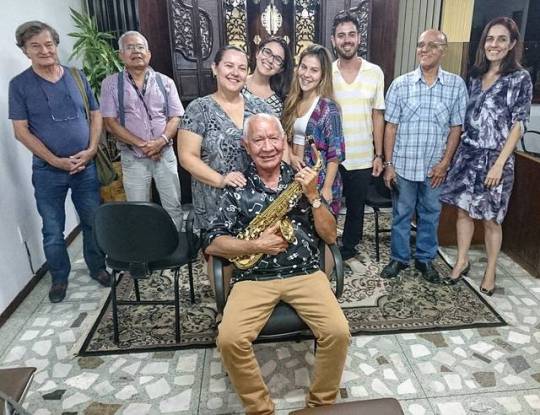
#Diálogo sobre o #Budismo #NichirenDaishonin promovido pela #BSGI #SGI na #AsaNorte #Brasília #NMRK #NamMyoHoRenGeKyo Tema: "O budismo classifica em dez categorias ou estados de existência as condições sempre mutáveis da vida. Este conceito é chamado de #DezEstadosDaVida #Jikkai". São eles: Estado de #Inferno #Jigoku Estado de #Fome #Gaki Estado de #Animalidade #Tikusho Estado de #Ira #Shura Estado de #Tranquilidade #Nin Estado de #Alegria #Ten Estado de #Erudição #Shomon Estado de #Absorção #Engaku Estado de #Bodisativa #Bosatsu Estado de #Buda #Butsu Se quiser saber mais a respeito é só perguntar! (em Asa Norte)
#bosatsu#nmrk#bsgi#bodisativa#brasília#diálogo#tranquilidade#ira#inferno#shomon#absorção#jigoku#fome#ten#budismo#erudição#alegria#dezestadosdavida#asanorte#buda#nichirendaishonin#gaki#tikusho#animalidade#jikkai#butsu#shura#nammyohorengekyo#sgi#nin
0 notes